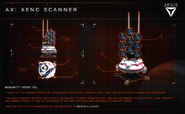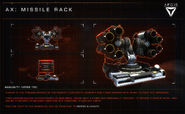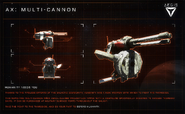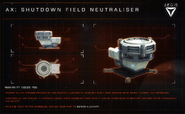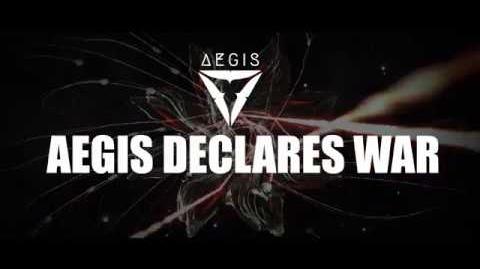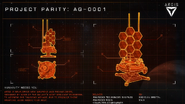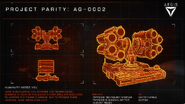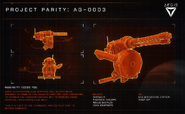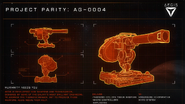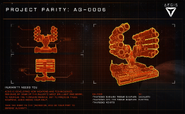Aegis is a multinational research initiative that was founded jointly by scientists from the Federation, Empire, and Alliance on August 4, 3303. The organisation's goal is to pool the three superpowers' scientific expertise to gather further intelligence on the Thargoids and coordinate all future research[1] as well as coordinate defence and rescue operations.[2] The superpowers' governments were responsible for providing the bulk of Aegis's funding, and they considered any attempt to deprive Aegis of xenological resources to be a criminal act punishable by law within their territories.[3]
Aegis was represented by three minor factions: Aegis Research, Aegis Core, and Aegis Defense. Aegis Research's headquarters was Donar's Oak in Delphi. Aegis Core was based in Sol, where it operated the Eagle Eye array under the protection of the Federal Navy; it was originally headquartered in Dantec Enterprise in Socho before a surge in criminal activity there caused disruptions to Eagle Eye. Lastly, Aegis Defense controlled the Megaships sent to respond to systems experiencing a Thargoid Incursion.
Aegis was partially suspended and many of its operations were terminated on July 27, 3307 after the superpowers launched an independent investigation into the disappearance of the Alexandria.[4] The investigation concluded on January 12, 3308 with a recommendation to dismantle the organisation, which the superpowers accepted. Aegis was formally shut down on January 18, 3308, with its military and xenological research responsibilities assumed by the superpowers' navies and universities. Full demobilisation of Aegis's staff, ships, and resources was expected to take several months to complete.[5][6]
Aegis was officialy reformed on February 13, 3309 following the massive Thargoid invasion of the core systems.[2] It is newly led by Professor Alba Tesreau, who tenaciously called for the restoration in the previous year.[7] Its new headquarters are located in the Duamta system.[8] Each superpower has a delegate to oversee and coordinate its contributions, and the new, streamlined organisational structure takes an example from the Affiliated Counter-Terrorism unit. The bureaucratic departments and approval processes are streamlined and prioritised research projects can begin without superpower approval. The Empire provided a limited application of Omega Grid networking to facilitate rapid and secure communications between key members. The new Aegis also lessened the reliance on independent pilots and makes efforts for better transparency and clearer strategy.[2][9]
History[]
Founding and early activities[]
The formation of Aegis was announced by Professor Alba Tesreau at a press conference in the Sorbago system on August 4, 3303. With all three superpowers providing financial backing, Aegis established a research outpost of its own in the Pleiades Nebula: the Ocellus station Donar's Oak in the Pleiades Sector IR-W d1-55 system, which was later renamed Delphi.[1]
On September 21, 3303, following the destruction of a Federal fleet in the Pleiades Sector IR-W d1-55 system by Thargoids, the three superpowers widened Aegis' remit to focus on defence in addition to research. The organisation's budget was also dramatically increased.[10]
Project Parity[]
That same day, Aegis also announced that it had recruited the Engineers Liz Ryder and Professor Palin to develop new offensive and defensive technologies. Palin's project, designed AG-0001, was a scanner intended to provide meaningful data on Thargoid ships. Ryder's project, designated AG-0002, was a missile launcher that was calibrated to damage the Thargoids. Both Engineers issued a request for Thargoid materials to help them complete their devices.[11] On September 28, the devices, formally named the AX Missile Rack and AX Xeno Scanner, were made available at military, high-tech, and industrial planetary bases across human space.[12][13] Aegis' military liaison Admiral Aden Tanner also announced a second initiative to develop anti-Thargoid weapons, which supported the production of AG-0003.[14][15] The second campaign was successful and produced the AX Multi-cannon.[16]
On October 5, 3303, Professor Tesreau announced a third phase of its anti-Thargoid program to produce AG-0004.[17] On October 6th, Aegis' military liaison Admiral Tanner confirmed that in recent days, Federal, Imperial, and civilian ships alike had been targeted and destroyed by Thargoids, and that the aliens were scanning the wreckage and seizing escape pods. Tanner reaffirmed that Aegis was dedicated to unraveling the Thargoids' motives.[18] The third campaign was successful and produced the Remote Release Flak Launcher.[19]
On October 12, it was announced that the fourth phase of Aegis' projects was being overseen by Engineer Elvira Martuuk, who revealed her plans for a device that would protect human ships from the Thargoids' immobilisation fields.[20] Meanwhile, an Aegis spokesperson noted that as well as adapting their defenses to human weapons technology, the Thargoids were also rapidly adapting to human strategies and tactics.[21] The fourth campaign was successful and produced the Shutdown Field Neutraliser.[22]
Infrastructure expansion[]

Artemis Lodge in Celaeno
Following the withdrawal of Federal and Imperial forces from the Pleiades Nebula, ending the cold war over meta-alloys, Aegis planned to establish over 20 new orbital outposts in the coming months to consolidate their presence and bolster their research and defense capabilities. Cavalieri in Electra and Goya Landing in HIP 16753 were the first two of these new stations to be built.[23]
| Station | System |
|---|---|
| Agricola's Ascent | Pleiades Sector DL-Y d65 |
| Arc's Faith | HR 1183 |
| Artemis Lodge | Celaeno |
| Asami Orbital | Pleiades Sector JC-V d2-62 |
| Bao Landing | HIP 17497 |
| Bennington's Rest | 42 n Persei |
| Borrego's Vision | Pleiades Sector IH-V c2-7 |
| Cavalieri | Electra |
| Cleaver Prospect | Pleiades Sector HR-W d1-57 |
| Copernicus Observatory | Asterope |
| Cornell's Garden | Pleiades Sector GW-W c1-13 |
| Corrigan Terminal | Pleiades Sector HR-W d1-74 |
| Cyllene Orbital | Atlas |
| Exodus Point | Hyades Sector AB-W b2-2 |
| Goya Landing | HIP 16753 |
| Ieyasu Dock | Pleiades Sector PD-S b4-0 |
| Kamov Survey | HIP 17892 |
| Kipling Orbital | Pleiades Sector KC-V c2-11 |
| Liman Legacy | HIP 16753 |
| Malthus Terminal | Pleiades Sector HR-W d1-41 |
| Oort Orbital | Pleiades Sector KC-V c2-4 |
| Rix Depot | Pleiades Sector IH-V c2-5 |
| Titan's Daughter | Taygeta |
Warnings[]
On October 27, as losses of Federal Farragut-Class Battle Cruisers and Imperial Majestic-Class Interdictors continued to mount, Admiral Tanner noted that although recent developments like the Shutdown Field Neutraliser had proven effective in protecting conventional spacecraft from Thargoid attacks, difficulties had been encountered in adapting the technology to larger spacecraft. As a result of capital ships' continued vulnerability, Tanner warned that deploying such vessels to protect stations and outposts was not a viable defensive strategy against Thargoids for the time being.[24]
Operation Andronicus[]
On November 2, 3303, Aegis launched Operation Andronicus, a military operation intended to curb Thargoid aggression in the Pleiades Nebula. Admiral Tanner stated that Aegis would be offering substantial monetary rewards to independent pilots for confirmed Thargoid kills.[25] The campaign concluded a week later and was declared a success that delivered a strategic blow to the Thargoid presence in Pleiades Sector IR-W d1-55. As Tanner explained: "The operation's success proves that small ships, when piloted by seasoned Commanders, are our best hope of addressing the Thargoid threat, at least for the present. Every pilot who took part in this initiative has my sincere gratitude."[26]
Further advancements and research[]
On November 10, 3303, a Faulcon DeLacy representative announced that it had teamed up with Aegis to produce an anti-Thargoid variant of the Taipan fighter, the Taipan AX1, which would be available for purchase beginning on November 13. Engineer Barr Winters explained that the new Taipan variant was equipped with two enhanced AX Multi-cannons to optimise its effectiveness against Thargoid vessels.[27]
On November 23, Aegis announced a second military strike focusing on Thargoids in the Electra system. This operation had two goals: to reduce the Thargoid presence in Electra, and to collect additional Thargoid materials for the production of upscaled anti-Thargoid weapons.[28] The campaign was a success, and Class 3 versions of the AX Missile Rack and AX Multi-cannon were made available at military outposts.[29]
On December 2, Aegis announced a large-scale expansion of its research division through the addition of 25 laboratories in starports throughout human space. Most of these labs were installed in the stations built under Aegis's prior infrastructure expansion in the Pleiades.[30] By December 8, Aegis reported that the new research initiative had already achieved some early successes. Researchers were focusing on Thargoid Probes and Thargoid Sensors, and had made headway in understanding how the Thargoids stored and transmitted information. Study of Thargoid star maps also revealed that the Thargoids categorised geographical data differently from humans.[31]
On the frontlines[]
Thargoid attacks on Aegis labs[]
Following the breakthroughs, three stations participating in Aegis' initiative were attacked by Thargoids on December 14: Liman Legacy in HIP 16753, The Oracle in Pleiades Sector IR-W d1-55, and Titan's Daughter in Taygeta. Previously undocumented Medusa Variant Thargoid Interceptors neutralised the stations' defenses with shutdown fields before launching a devastating barrage of firepower that left the stations crippled and dangerously unstable. Emergency protocols were activated and Pilots Federation Rescue Vessels were deployed to evacuate pilots and civilians.[32][33] Authorities in Taygeta later issued a statement saying that the situation was under control, and urged the public not to panic. While it was not clear why the Thargoids had targeted these three stations specifically and not others, Aegis confirmed it was investigating.[34] Additional attacks occurred over the following weeks; these were also perpetrated by Medusa Interceptors, and also targeted stations participating in Aegis' initiative.[35][36] A starport personnel member at Kipling Orbital noted that the Thargoids seemed to be sweeping the region and slowly moving towards the core systems,[37] and Emperor Arissa Lavigny-Duval later confirmed that Aegis was investigating this development as well.[38]
| Date of Attacks | Stations Damaged |
|---|---|
| December 14, 3303 | Liman Legacy, HIP 16753 The Oracle, Pleiades Sector IR-W d1-55 Titan's Daughter, Taygeta |
| December 21, 3303 | Bao Landing, HIP 17497 Cavalieri, Electra Hudson Observatory, HIP 17694 |
| January 4, 3304 | Copernicus Observatory, Asterope Cyllene Orbital, Atlas Artemis Lodge, Celaeno |
| January 11, 3304 | Obsidian Orbital, Maia Reed's Rest, Merope |
| January 18, 3304 | Kipling Orbital, Pleiades Sector KC-V c2-11 Malthus Terminal, Pleiades Sector HR-W d1-41 |
| January 25, 3304 | Borrego's Vision, Pleiades Sector IH-V c2-7 Kamov Survey, HIP 17892 |
| February 1, 3304 | Asami Orbital, Pleiades Sector JC-V d2-62 Cleaver Prospect, Pleiades Sector HR-W d1-57 |
| February 8, 3304 | Bennington's Rest, 42 n Persei Exodus Point, Hyades Sector AB-W b2-2 |
| February 15, 3304 | Gaiman Dock, 49 Arietis Weyn Dock, 64 Arietis |
| February 22, 3304 | Armstrong Enterprise, Bhal Beaufoy Vision, Nauni |
On February 24, 3304, Aegis finally confirmed that the Thargoids had been specifically targeting Aegis laboratories, and announced that defensive measures would be increased at all stations where the organisation had a presence. Professor Tesreau surmised that the Thargoids were actively trying to prevent Aegis from analyzing Thargoid artefacts, and speculated that a long-term solution might be to build new laboratories in secret locations such as bunkers and asteroids. Tesreau insisted Aegis's research was critical to understanding the Thargoids in the hopes of one day establishing a rapport with them and ending the conflict.[39]
Station attacks seemingly ceased after February 22, when the Aegis labs at Armstrong Enterprise in Bhal and Beaufoy Vision in Nauni were targeted. Both systems were located well within the frontier of the core systems, and were also the two most distant systems from the Pleiades that had hosted Aegis labs. Beginning on February 27, however, pilots began reporting encounters with groups of hostile Thargoid Scouts in other frontier systems such as Umbila and Huveang De, indicating that the Thargoid conflict was far from over.
Additional countermeasures[]
On January 12, 3304, Aegis announced that it had made new Decontamination Limpets available at military, high-tech, refinery, industrial, and extraction planetary bases. These new Limpets were designed to counter the caustic damage inflicted by Thargoid Interceptor missiles. Previously, caustic contamination could only be purged from ships by overheating them to a dangerous level, a risky tactic during combat. An Aegis spokesperson described the device's function: "As we know, the Thargoids' enzyme missiles are particularly dangerous because of the caustic damage they inflict. The decontamination limpet is designed to address this by stripping the corrosive enzymes from a ship's hull while also performing limited repairs."[40]
Following Ram Tah's breakthroughs with Guardian technologies, Professor Tesreau announced on March 7 that she had contacted Ram Tah to request access to his data. With the revelation that the Guardians had once fought and won a war against the Thargoids, it was hoped that Guardian research could provide a deeper understanding of the Thargoids and their motives in attacking human space.[41]
Eagle Eye[]
On March 9, 3304, Aegis announced a new operation to counter the Thargoids. The initiative, called Eagle Eye, involved placing six orbital surveillance installations in systems around the Pleiades, namely HIP 17225, HIP 17692, HIP 17892, HR 1185, Pleiades Sector IR-W d1-55, and Pleiades Sector KC-V c2-4, in order to monitor known Thargoid Surface Sites and collect data on Thargoid behavior outside of combat zones.[42]
By March 16, Aegis reported that Eagle Eye was already producing results. According to Admiral Tanner, the installations were able to track fluctuations in transmissions originating from Thargoid Surface Sites, and that these transmissions pointed to specific locations in human space which were likely future Thargoid attack targets. Tanner urged independent pilots to investigate a new set of signals detected by Eagle Eye to help thwart the Thargoids' plans.[43]
The Purge of Socho[]
On March 15, 3304, Aegis Core announced an anti-Thargoid campaign in the Socho system. The operation's goal was not only to expel Thargoid forces from Socho, but to obtain specific technological components from Thargoid Interceptors and Scouts for comparison research.[44] The operation concluded successfully.[45]
Escalations and revelations[]
A number of developments occurred on March 22, 3304. Aegis deployed two military flagship Megaships, the Acropolis and the Vanguard, to the Irandan and HIP 21559 systems respectively, both of which had been identified by Eagle Eye as targets for imminent Thargoid attacks. While HIP 21559 was spared thanks to the heavy presence of independent pilots, Glazkov Terminal in Irandan was hit, making it the first station be attacked since February 22.
Later that same day, Aegis published a report containing significant insights into the Thargoids that had been gleaned with the help of Ram Tah and his Guardian research. The findings indicated that the Thargoids had warred with the Guardians because of the latter's perceived encroachment on territory that the Thargoids had seeded with Alien Structures millennia earlier. Despite attempts by the Guardians to communicate with the Thargoids, the Thargoids' survival instincts were so strong that they refused to tolerate any potential threat and continued hostilities until the Guardians eventually expelled them using automated war machines. Professor Alba Tesreau commented that the Guardians' situation mirrored humanity's own: the Thargoids had long ago seeded territory that humans had unknowingly expanded into, and the current conflict was essentially a dispute over territory and resources. Tesreau asserted that the next step the Thargoids would take would be to aggressively mine mineral resources. Ram Tah noted that these revelations finally provided some answers about the Thargoids' overall goals and could ultimately aid humanity in the conflict.[46]
On March 29, Admiral Tanner announced that Eagle Eye had detected no new signals from Thargoid Surface Sites, which he believed indicated a brief reprieve in the Thargoids' attack plans. The Acropolis and Vanguard remained stationed in Irandan and HIP 21559 while Aegis awaited further developments.[47] Tanner elaborated on the purpose of Aegis's new flagships on March 30, explaining that they would serve as command centers for anti-Thargoid operations and that they would be periodically moved to wherever they could be strategically effective.[48]
Rising controversy[]
Criticism[]
On April 5, Aegis became the target of criticism from Princess Aisling Duval, who accused the organisation of moving too slowly and lacking a clear strategy for combating the Thargoids. While her viewpoint garnered some support, Federal and Alliance media outlets roundly derided her statements as a ploy for attention and cited multiple examples of Aegis's recent achievements.[49] On April 12, more prominent figures expressed measured support for Princess Duval's statements, including Senator Pal Vespasian, Alliance Defence Force Commodore Riri McAllister, and journalist Jast Fernández. They noted that Aegis's victories thus far were not enough to assuage public fears of an imminent Thargoid conquest and suggested Aegis should be more transparent about its long-term plans.[50]
On May 9, Admiral Tanner responded to the widespread disquiet over the Thargoids' advance into the core systems. Tanner dismissed reports that the Thargoids were invading en masse, insisting that no full-scale invasion was occurring and deploying capital fleets was unncessary. He urged the public to remain calm and thanked independent pilots for helping to halt the Thargoids' progress.[51]
Anarchy in Socho[]
On May 30, in a stunning development, Aegis Core was ousted from control of its headquarters in the Socho system by the Socho Gold Raiders criminal faction. A courier managed to escape the system with a message from Dr. Mia Valencourt of Aegis Core detailing the attack and calling for assistance. According to Dr. Valencourt, the Socho Gold Raiders had become convinced that Aegis was constructing a superweapon, and crushed the system's security forces by luring them into a trap using a falsified Thargoid signal. Professor Alba Tesreau denounced the attack, noting that Aegis Core was conducting vital anti-Thargoid research, and issued a plea for aid from the galactic community.[52]
Continued efforts[]
Starport restoration drives[]
With numerous stations still undergoing repairs after Thargoid attacks, Aegis Research and Aegis Core launched simultaneous public initiatives on May 31, 3304 to collect and distribute construction materials to damaged stations in the Pleiades Nebula and core systems, respectively. Senior Engineer Lilith Galloway took charge of the Aegis Research campaign at The Oracle in Pleiades Sector IR-W d1-55, while Chief Administrator Carter Armstrong led the Aegis Core campaign at Dantec Enterprise in Socho.[53][54] Both campaigns were successful.[55][56]
Building on success[]
On June 21, 3304, Aegis declared that the Thargoids were retreating from the core systems and had been pushed back to their original beachhead of Bhal. Admiral Tanner thanked Commanders for their efforts in defending the core systems, but noted that while Thargoid Incursions had been reversed in many regions, the Thargoids remained entrenched in the Pleiades Nebula.[57]
Meanwhile, Aegis Core and Aegis Research announced that three stations attacked by the Thargoids in recent months have completed repairs. Armstrong Enterprise in Bhal, Beaufoy Vision in Nauni, and Reed's Rest in Merope were restored to full functionality.[58]
Aegis also announced plans to construct a new military Installation in Pleiades Sector IR-W d1-55 in response to the recent criminal incursion in Socho. The new Installation, named The Sentinel, would allow Aegis to focus its efforts on the Thargoids without fear of further disruption.[59] The campaign was successful.[60]
On June 28, Aegis announced that it had supplied Technology Brokers with additional funding, resources, and manufacturing equipment, allowing them to reduce the cost of their services. According to Senior Engineer Henrik de Lacerda, the move was an act of appreciation for the independent pilots working to defend the core systems, and intended to increase access to Tech Broker modules in order to improve humanity's overall combat effectiveness against the Thargoids.[61]
Thargoid counterattacks[]
On June 28, Aegis reported that Eagle Eye had detected a massive surge in Thargoid transmissions. Admiral Tanner asserted that the previous week's lull in activity in the core systems must have been only a brief delay while the Thargoids regrouped and summoned reinforcements from the Pleiades. Tanner issued an emergency call for aid for Garay Terminal in Deciat, which Eagle Eye indicated was the Thargoids' main target. A transmission from an unknown Commander operating in the Deciat system also indicated that a new type of Thargoid Scout was present among the invading force.[62]
Meanwhile, independent pilots discovered a surface settlement called Dominic's Corner on moon 12 a in Pleiades Sector GW-W c1-15 that had been attacked by Thargoids, one of several such sites. The location was found by triangulating a signal received by three listening posts in Maia. According to logs recovered from the site, Dominic's Corner was an independent manufacturing facility that had been contracted by Aegis to produce anti-Thargoid weaponry. Following a visit by an Aegis representative who identified himself only as "Mr. Black", the facility received a message over an encrypted channel from Mr. Black warning of an imminent attack and urging staff to evacuate; one employee, Secretary Miller, remained behind to dispose of confidential material so that it wouldn't fall into the wrong hands. When the attack came, it was not raiders as expected, but a Thargoid Interceptor, which proceeded to demolish the facility until it was driven off by the sudden arrival of a contingent of Federation ships.[63]
Pleiades rescue operation[]
On August 9, 3304, Aegis Research launched a search-and-rescue initiative in conjunction with local system authorities in the Pleiades Nebula to recover the escape pods of Thargoid attack survivors and provide them with adequate food. Superintendent Maria Poulsen stated, "System authorities in the Pleiades have been channelling their resources into combating the Thargoid menace. As a result, search-and-rescue initiatives have been neglected, but we are determined to plug that gap. That means a lot of civilians rescued from escape pods, which also means a lot of hungry mouths to feed, so we'll need to bolster our current food stocks as a precautionary measure." Pilots were requested to deliver the escape pods and goods to Donar's Oak in Pleiades Sector IR-W d1-55.[64] Superintendent Poulsen subsequently confirmed that the operation was a success: "The number of rescued survivors we have received is truly fantastic. We have also received enough food stocks to ensure that they're well taken care of, before moving them to dedicated refugee centres."[65]
Aegis Core relocates[]
On August 30, 3304, in response to the repeated disruption of Aegis Core's operations in Socho over previous months and the ongoing deterioration of conditions there, Federal President Zachary Hudson announced that Aegis Core would be relocated from Socho to Sol, where it could be better protected. President Hudson underscored the announcement with a clear warning: "Aegis has been charged with defending humanity, and any attempt to undermine it is nothing less than an act of treason."[66] The relocation process was completed on July 4, 3305.[67]
Thargoid Sensors neutralised[]
On November 29, 3304, Senior Engineer Henrik de Lacerda of Aegis Research announced a breakthrough in Meta-Alloy research that allowed extremely small quantities of Meta-Alloys to provide sufficient protection against Thargoid Sensor-related interference, and arranged for shipments of Meta-Alloys to be distributed to affected stations. As Thargoid Sensors ceased to cause technological damage to stations, the sale of Thargoid commodities in general was legalised, allowing them to be traded in public markets.[68][69]
Protecting Ram Tah[]
On November 30, Professor Alba Tesreau announced that Aegis had stationed a security force in the Meene system to provide additional protection for Engineer Ram Tah and his ongoing development of Guardian-human hybrid technologies. The deployment came in the wake of a series of mercenary attacks on Ram Tah's Phoenix Base organised by a cabal of rogue Sirius Corporation junior naval officers. The attacks coincided with Sirius Corp CEO Li Yong-Rui's public entreaties to Ram Tah to work together on hybrid technology production, causing many to believe that the attacks may have been a deliberate attempt to intimidate Ram Tah into sharing his work with Sirius. Sirius Corp did not respond to the news of the Aegis deployment to Meene, but it was rumoured that Li Yong-Rui had withdrawn his offer to Ram Tah. Professor Tesreau emphasised that Ram Tah's products were invaluable in the Thargoid conflict, and as such Aegis had a vested interest in protecting the Engineer's operation and independence.[70]
Incursions, divisions, and new tactics[]
Aegis Defense[]
Aegis debuted a new branch, Aegis Defense, on December 27, 3304 following the Thargoids' most devastating attack yet. Five systems were beset by Incursions, resulting in simultaneous attacks against five stations: Behnken Gateway in Wuli, Bethke Ring in Werapana, Cavalieri in Electra, May Gateway in Kupol Vuh, and Mendez Terminal in Jormbu. With the Acropolis and Vanguard either missing or withdrawn, Aegis instead deployed five new Megaships to the afflicted systems to serve as additional bulwarks for independent pilots fighting the Thargoids in AX Conflict Zones. In addition, GalNet began posting the automatically-updated Thargoid Activity Report, which tracked Thargoid activity levels in systems experiencing an Incursion alongside repair progress for previously damaged stations.
Cracks in the Empire[]
Meanwhile, cracks had begun to appear within the Empire, as the hardliner group Nova Imperium gained supporters among the public and the Imperial Senate by espousing a strategy of isolation and disengagement from the Federation and Alliance as the best way to survive the Second Thargoid War. Emperor Arissa Lavigny-Duval refused to publicly address Nova Imperium and the appearance of Hadrian Augustus Duval, a long-lost grandson of the late Emperor Hengist Duval who had been presented as Nova Imperium's figurehead. Both Federal President Zachary Hudson and Alliance Prime Minister Edmund Mahon spoke out against the rise of Nova Imperium before their respective legislatures on December 29. Mahon expressed concern about the possible cessation of inter-superpower cooperation, but Hudson took a bolder stance and asserted that the Federation would be forced to intervene for the sake of the war effort against the Thargoids should Nova Imperium come to power and halt the Empire's contributions to Aegis. Independent sources confirmed that Federal Navy resupplies had increased in frequency, and Federal fleets were conducting exercises in regions bordering Imperial territory.[71]
Partnership with Ram Tah[]
On April 17, 3305, Aegis Research Senior Engineer Lilith Galloway announced that Aegis had formally partnered with Engineer Ram Tah to boost the production of ship modules derived from Guardian technology. The three Guardian hybrid fighters, the XG7 Trident, XG8 Javelin, and XG9 Lance, would continue to be licensed to Technology Brokers for distribution. Ram Tah issued a statement of his own expressing his delight and confidence in the arrangement.[72] The welcome development came after large-scale Thargoid attacks in the core systems had stretched defense efforts thin and damaged more stations than in the entire previous year.
Unusual strategy[]
Admiral Aden Tanner commented on the state of the war on April 18: "What's surprising is that the Thargoids aren't targeting our most important social or military centres, such as the superpowers' home systems. There's no doubt that they’re trying to weaken us, but evidently they're guided by different principles than those that typically govern human martial strategy. What we can say is this: with capital ships of limited use against Thargoid craft, independent combat pilots remain our best defence against the Thargoids."[73]
Meta-Alloy shortage and The Enclave[]
On July 4, 3305, reports emerged that harvests of Meta-Alloys were in steep decline, and many known Thargoid Barnacle sites had become exhausted. Professor Alba Tesreau announced an initiative to locate alternative Thargoid Barnacle sites by collecting and analyzing exploration data provided by independent pilots at The Oracle in Delphi.[74] On July 11, Tesreau revealed that the survey had turned up new sites in the Witch Head Nebula, and the Alliance, Empire, and Federation each launched concurrent resource-gathering campaigns in order to build new infrastructure in the region.[75]
At the same time as the Meta-Alloy shortage, Aegis reported that Thargoid forces had, in a matter of hours, completely withdrawn from the core systems and the Pleiades Nebula with the exception of the Maia and Merope systems. Admiral Aden Tanner explained that Aegis's two main theories for the Thargoids' departure were that their numbers had been depleted or they were reconsidering their strategy. Whatever the cause, Eagle Eye confirmed the development and reported "No Activity Detected" for that cycle. Professor Ishmael Palin urged caution, however, warning that the war with the Thargoids was likely far from over and there was no evidence that human activity had prompted this retreat.[76]
On July 18, the Thargoids returned to the Pleiades Nebula in large numbers, attacking three stations without being detected by Eagle Eye and massing in Maia for an attack on Palin Research Centre. Professor Palin and his staff managed to evacuate to the Megaship Carson's Spring before the surface port came under fire, but the vessel was attacked and disabled before it could depart Maia. Professor Tesreau asserted that the Thargoids were likely attempting to reassert themselves in their original territorial claim, and requested help from independent pilots in defending Carson's Spring, as local security forces were overwhelmed.[77] Defence efforts were successful, and Carson's Spring was able to resume its journey to the Arque system. Professor Palin began rebuilding his operation at Abel Laboratory on Arque 4 e,[78] and resumed his research on services on July 30.[79]
On July 25, as Ocellus Starports arrived in six systems in the Witch Head Nebula that had been slated for colonisation as part of The Enclave initiative, they were immediately attacked by Thargoid forces that were ostensibly acting to defend their territory. Professor Tesreau called on independent pilots to defend the stations, or else the pioneer factions in charge of the colonisation effort would be forced into retreat and access to the new Meta-Alloy sources in the region would consequently be cut off.[80] On July 31, Admiral Tanner proclaimed victory, noting that humanity's colonial assets had been firmly established in the region thanks to the efforts and sacrifices of independent pilots. Professor Tesreau added that the Alliance, Empire, and Federation had officially declared the Witch Head Nebula to be a human enclave that they would share equally. She also requested the galactic community's assistance in repairing the nebula's starports so that they could begin harvesting the local barnacles.[81]
By August 6, the Witch Head Nebula enclave had begun attracting thousands of migrants looking for a fresh start. Among these was Chloe Sedesi, a former apprentice of Professor Palin who sought to establish an Engineering workshop at Cinder Dock in Witch Head Sector DL-Y d17. A Technology Broker and Material Trader also planned to move to the area and set up at Bray Landing and Ratchet Hub.[82][83] The second colonisation wave arrived on August 8, resulting in the completion of seven planetary ports, including Chloe Sedesi's workshop. The Technology Broker and Material Trader also arrived ahead of schedule. With repairs to the starports progressing swiftly, Professor Tesreau confirmed that more facilities were planned for the Witch Head Nebula in the coming weeks.[84]
The successful defence of the new enclave was followed by 22 consecutive weeks of relative peace. The Thargoids returned in force on January 9, 3306, however, launching Incursions in three systems in the Witch Head Nebula and three in the Pleiades Nebula. Professor Tesreau commented on the development, which had caught the complacent Witch Head colonists off-guard: "Regrettably, the Thargoids were unlikely to surrender this area of space after a single defeat. Humanity may have established the Witch Head enclave, but the Thargoids are clearly still intent on driving us out – particularly with so many barnacle sites in the region."[85] This was reinforced months later on October 15, 3306, when Thargoid presence in the Witch Head systems of Onoros, Lembass, Haki, Wellington, and Shenve intensified, a possible prelude to a larger invasion. With Aegis unable to come to the enclave's aid in time, local factions requested assistance from independent pilots.[86] Fortunately, the response to this call for aid was overwhelming. The bulk of the Thargoid assault force was destroyed, and the remainder were driven into headlong retreat.[87]
Changing priorities[]
Meanwhile, relations between the Federation and the Empire had reached a breaking point as a result of the Neo-Marlinist Liberation Army terrorist group. Both sides ramped up military spending, and on November 27, 3306, Senator Denton Patreus ordered the withdrawal of Imperial funding from Aegis as the Empire changed its focus from the subsiding Thargoid threat to countering the Federation and the NMLA.[88] The Federation reportedly followed suit and withdrew its own funding from Aegis. On December 10, Commodore Morag Halloran of the Alliance Defence Force commented that the recently established Coalsack Nebula colonies were vulnerable to Thargoid attacks, as the ADF's response time would be slow due to the distance involved and Aegis had been impacted by the loss of Federal and Imperial funding.[89]
The Thargoids finally struck again on December 31, 3306, simultaneously launching Incursions into nine systems, three in the Coalsack Nebula and six in the Witch Head Nebula. The Alliance Defence Force was, as feared, too slow to prevent the infestations, and local security forces reported being overwhelmed. Admiral Aden Tanner warned that Aegis could not adequately respond to the situation due to the recent funding and resource cutbacks, and called on independent pilots to provide assistance.[90] Thousands of colonists were confirmed dead on January 7, 3307 as the offensive entered its second week, with only two of the nine affected systems cleared of Thargoid Incursions. Admiral Tanner reiterated that the nebula colonies had no other option but to rely on independent pilots for protection from the alien threat.[91]
Tarnished shield[]
The Galactic Summit and new research project[]
On January 8, Professor Alba Tesreau urged the superpowers to attend Simguru Pranav Antal's proposed Galactic Summit and recommit to supporting Aegis in light of the Thargoid resurgence, stating that coexistence would only be possible with the Thargoids through greater understanding achieved through rigorous research.[92]
On March 3, 3307, during the Galactic Summit in Sirius, several independent ambassadors demanded that discussions on the Thargoid issue and the defensive role played by Aegis be prioritised.[93] Prime Minister Edmund Mahon proposed the Sirius Treaty on March 4, which would greatly expand Aegis's remit and unite the superpowers, corporations, and independent systems against the Thargoids.[94] On March 9, following a broad agreement among the delegates to increase funding for Aegis in exchange for a promise of new breakthroughs in anti-Thargoid technology and Guardian research, the Sirius Treaty gained the support of Archon Delaine of the Kumo Crew pirates, the Marlinist Colonies, and several other independent groups.[95] However, the Galactic Summit was interrupted by the Nine Martyrs attack on March 11, and the delegations returned home without signing the Sirius Treaty.
Aegis began making good on the promise it made at the summit on April 22 when Professor Tesreau unveiled a campaign to collect Guardian artefacts to research new anti-Thargoid defences. Aegis Research deployed a new Megaship, Alexandria, in the Delphi system to host the initiative, and Professor Tesreau pledged access to Guardian Gauss Cannons from Technology Brokers as an extra incentive for participants. In addition, Alexandria temporarily contracted a Guardian Technology Broker, and offered to extend their contract for extra weeks depending on the initiative's success.[96] The campaign met its goal by April 29, and Professor Tesreau thanked contributors. As the research project entered its early stages, there were no signs of imminent breakthroughs.[97]
Flight of the Alexandria[]
The Aegis appeal may have indirectly provoked the Thargoids, however, as on May 13, 3307, countless Thargoid ships swarmed into ten systems: Atlas, Celaeno, Coalsack Sector KN-S b4-9, Coalsack Sector VU-O b6-6, HIP 18390, HIP 62154, HR 1183, Musca Dark Region PJ-P b6-1, Pleiades Sector HR-W d1-74, and Delphi itself. Local starports were heavily damaged, and Aegis mobilised its available defences and called for volunteers. Professor Tesreau surmised that the high concentration of Guardian artefacts delivered to the Megaship Alexandria in Delphi may have set off the Thargoids' deeply instilled aversion to Guardian technology.[98]
On May 20, the Alexandria embarked on a journey to Sol and jumped from Delphi to HIP 16538, where it planned to restock tritium. The Thargoids followed, trapping the Alexandria in the system and endangering the local civilians. Admiral Aden Tanner requested volunteers to come to the Megaship's aid before its important cargo of Guardian artefacts was lost.[99] On May 24, the Federal Navy barred the Alexandria from entering any Federal system over fears that it would bring Thargoids and cause more Incursions. Wishing to avoid jettisoning the ship's important cargo, it was decided that as soon the Incursion in HIP 16538 had been cleared, the Alexandria would jump a system with a minimal population to offload the Guardian artefacts.[100]
HIP 16538 was cleared of Thargoids by May 27. On June 1, the Alexandria's captain, Jacob Morales, announced plans to jump the Megaship to the HIP 30944 system on June 3, where the cargo of Guardian artefacts would be offloaded and distributed to multiple locations. For safety reasons, Captain Morales asked all independent pilots aboard the Alexandria to depart before the jump was set to take place, and warned that any private ships still docked immediately prior to the jump would be jettisoned.[101] The Alexandria departed as scheduled, but never arrived in HIP 30944. Search teams found no trace of it in nearby systems. On June 4, Admiral Aden Tanner declared the Megaship to be missing, with Captain Morales and his crew of four thousand classified as missing presumed dead. Tanner posited that the Alexandria had been hyperdicted by the Thargoids. The loss of the Alexandria's cargo also dealt a severe blow to Aegis's Guardian technology research project.[102]
The Proteus[]
The surprise discovery of the Proteus, an exploration ship tied to the Azimuth Biochemicals Megaship Hesperus, and a Guardian-Thargoid War battlefield on moon 1 a in the Trapezium Sector YU-X c1-2 system on June 11, 3307 breathed new life into Aegis's research project. On June 18, Professor Tesreau announced that Aegis Research advance teams had already arrived on the scene to survey the ancient site, and another Megaship, the Archimedes, was being prepared to support a deeper investigation. It was hoped that the newly-documented Guardian sites could provide another source of Guardian artefacts.[103]
Aegis's plans for Trapezium Sector YU-X c1-2 encountered opposition from the enigmatic Salvation when he directed his proxy Taurus Mining Ventures to press his exclusive claim over the battlefield site on June 24. Both the Archimedes and the Glorious Prospect, the Megaship dispatched by Taurus Mining Ventures, were used to host competing initiatives in the PMD2009 48 system to collect Guardian artefacts. In desperate need of new research material, Aegis pledged to temporarily reduce the costs of Guardian modules at Technology Brokers for all pilots if its initiative prevailed, while Taurus Mining Ventures offered a specially-engineered Guardian Shard Cannon for Salvation's supporters. Addressing concerns that the Archimedes could cause a repeat of the Thargoid attacks sparked by the Alexandria, Professor Tesreau explained that PMD2009 48 was situated much further from known areas of Thargoid activity than Delphi and therefore might escape their notice.[3] Unfortunately for Aegis, Salvation's campaign garnered vastly more support from the galactic community, and Taurus Mining Ventures representative Patience Middleton declared victory on July 1.[104]
Investigation and suspension[]
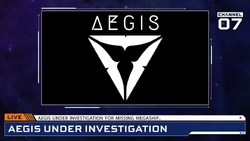
Aegis Under Investigation
The superpowers ordered the partial suspension of Aegis and launched an investigation into the Alexandria's disappearance on July 27. The move came amid a crisis in public confidence in Aegis in the wake of the Alexandria incident and the group's defeat by Salvation, whom some authorities suspected was the leader of an Aegis splinter group composed of rogue agents and stolen resources. All of Aegis's active projects were shut down for the investigation, and several senior members including Professor Alba Tesreau, Director Yazhu Xing, and Dr. Mia Valencourt were forced to resign. Admiral Aden Tanner remained in charge of Aegis's military activities, while routine operations continued under independent oversight. Dr. Paul Baumann was appointed the chair of the board of inquiry, and he provided an overview of the initial phase of the investigation to the public on August 11.[4][105]
Less than a week later, on August 17, the board of inquiry's initial findings leaked to newsfeeds. On their face, the files painted a picture of gross mismanagement within Aegis that verged on negligence. It was claimed that Aegis was complacent and had no plan to relieve independent pilots from shouldering almost all of the burden of confronting the Thargoids in combat. The development of new generations of AX weaponry and defences was also apparently sidelined, with Professor Tesreau preferring to focus on research into means of communicating with the Thargoids. Aegis personnel interviewed by the investigators indicated that they believed the inquiry was designed to scapegoat them, and they blamed the organisation's inefficiency on the superpowers' reduction of funding. Dr. Baumann responded to the leak by insisting that only the final version of what the media had begun referring to as the "Baumann Report", which was still in the process of being compiled, should be considered official.[106] By September 7, more key Aegis staff had resigned, and Dr. Baumann's inquiry had begun an audit of the organisation's financial records. Dr. Baumann also confirmed that should sufficient evidence be obtained, certain top Aegis figures could face charges of criminal negligence. In an interview with the Alliance Tribune that day, Alliance Prime Minister Edmund Mahon called the inquiry an unnecessary indignity that could have been prevented if the Sirius Treaty had been ratified at the Galactic Summit. Mahon further argued that the Sirius Treaty remained viable, and could immediately restore and strengthen Aegis if the other signatories agreed to implement it.[107]
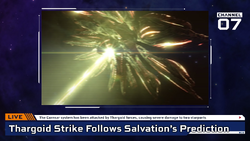
Thargoid Strike Follows Salvation's Prediction
In response to a public message broadcast by Salvation on September 14 that warned the Cornsar system would soon be attacked by the Thargoids, Chief Administrator Carter Armstrong stated Salvation's claim could not be validated by Aegis nor investigated due to the suspension. However, he made a point of noting that Cornsar was well outside known Thargoid territories and had no reason to be targeted. Marshal Noah Sharrow, the leader of Cornsar's controlling faction, concurred with Armstrong's dismissal, but emphasised that his government had no interest in the rivalry between Aegis and Salvation.[108] Unfortunately for the citizens of Cornsar, Salvation was vindicated on September 16, when Thargoid forces hit the starports Chadwick Port and Ito Market. Estimates of casualties exceeded ten thousand, and the system remained under threat due to the presence of Thargoid vessels. Marshal Sharrow issued a call for aid, while Aegis was unable to provide any support because of its ongoing suspension.[109] Unexpectedly, the Thargoid fleet withdrew from Cornsar on September 20, leaving behind numerous wrecks across several local worlds. Aegis confirmed the wreck sightings, but was unable to explain why the Thargoids had departed.[110] Salvation took credit for repelling the Thargoids on September 22, asserting that his anti-xeno superweapon had been tested successfully and that he had finally achieved what Aegis had long promised yet failed to deliver.[111] In the wake of this victory, Vox Galactica correspondent Alexei Keel reported on September 27 that although faith in Aegis had fallen to an all-time low, Salvation had also begun to accrue detractors who either did not trust his motivations or opposed fighting with the Thargoids.[112]
The Thargoids invaded the Pleiades Nebula and Witch Head Nebula on October 28, 3307. The systems Asterope, Evangelis, Haki, Lembass, Onoros, Pleiades Sector PD-S b4-0, Shenve, and Wellington were overwhelmed, and thousands of casualties were reported. Admiral Aden Tanner of Aegis expressed frustration that Aegis could not provide more assistance due to the Baumann investigation. Tanner also voiced his concern that Salvation's anti-xeno superweapon was to blame for the invasion, asserting that its use in Cornsar had provoked the Thargoids and could escalate the war.[113] As the offensive entered its second week and expanded into the HR 1183 system, Admiral Tanner took action. On November 5, 3307, Tanner broadcast that he had taken command of the Aegis Defense Megaship Musashi and moved it to T Tauri to conduct a search of Taurus Mining Ventures' headquarters, Hind Mine. Tanner believed that Salvation was using his anti-xeno superweapon to deliberately and recklessly provoke the Thargoids, and claimed to have sources who had confirmed that Hind Mine contained evidence of Salvation's misdeeds. Taurus Mining Ventures spokesperson Patience Middleton insisted her company's contracts with Salvation were legal and confidential. Other Aegis leaders condemned Tanner for relocating the Musashi without authorisation and ordered him to depart T Tauri.[114]
On November 11, at the start of the third week of the Thargoid offensive, Thargoid forces were completely expelled from Asterope, but the other affected systems remained under siege, and five new Incursions were reported in Celaeno, Coalsack Sector KN-S b4-9, Coalsack Sector VU-O b6-6, HIP 62154, and Musca Dark Region PJ-P b6-1. Also that day, Admiral Tanner acted on his own authority and launched an attack on the forces of Taurus Mining Ventures in T Tauri to gain access to Hind Mine and expose Salvation's secrets. Although Tanner was now openly defying Aegis leadership's orders to leave T Tauri, it was rumoured that many Aegis members quietly supported his actions and shared his view that the ongoing Baumann investigation should end. Patience Middleton issued a call for aid in defending against Tanner's illegal attack and protecting Salvation's work.[115] The battle ended in a bitter defeat for Tanner on November 18. Taurus Mining Ventures forces boarded and captured the Musashi, and Tanner himself was detained pending his transfer to Aegis's internal security teams. The Musashi's other Aegis Defense personnel were permitted to leave the Megaship unharmed.[116]
The Federal Navy announced on November 29 that Admiral Tanner would be court-martialed for his actions in T Tauri, and if found guilty he would be dishonourably discharged and imprisoned for life. The Aegis members who had crewed the Musashi under Tanner's command had similarly been repatriated to their home systems to face civil or military charges. Dr. Paul Baumann commented that the T Tauri incident would be factored into his inquiry's final report on potential misconduct by Aegis. It was also observed that although there was no direct evidence to support Tanner's claims that Salvation was deliberately provoking the Thargoids, coordinated strikes by Thargoid forces continued to affect multiple systems.[117] On November 30, freelance war correspondent Ernesto Rios reported for Vox Galactica that independent pilots were experiencing unusually strong resistance from the Thargoids, and the invaders' fleets were receiving a constant stream of reinforcements. With the Cornsar incident still fresh in the public consciousness and trust in Aegis lower than ever, the Imperial Navy and the Alliance's Council of Admirals had begun discussing the possibility of providing military support to Salvation, and Federal Congress had debated redirecting funds set aside for Aegis to Salvation to hasten the development of his anti-xeno superweapon. With neither Aegis nor Salvation providing direct support in active Thargoid conflict zones, however, the burden of protecting human colonies fell largely to independent pilots.[118]
On December 15, one day after the successful firing of three more anti-xeno superweapons that Salvation had arranged to be assembled in the besieged systems of Delphi, Maia, and Merope, Salvation issued a statement to all newsfeeds claiming credit for purging the systems of Thargoids and revealing his plans to "deliver a decisive blow" against the aliens in 3308. The secretive scientist also declared that Aegis was "finished" and urged the galactic community to unite behind his "crusade".[119] Alliance Prime Minister Edmund Mahon cited Aegis's long absence from the frontlines as a possible reason for the Thargoids' recent pattern of increased aggression when he announced the signing of an anti-xeno defence pact between the Alliance and Sirius Corporation on January 3, 3308.[120]
On January 5, 3308, Ram Tah testified on behalf of Admiral Aden Tanner at his court martial for the T Tauri incident. According to his analysis of the Classified Experimental Equipment used in Salvation's anti-xeno superweapon, the technology was Guardian in origin, and likely related to new devices found at the Proteus site months earlier. He hypothesised that the superweapon was an up-scaled Guardian weapon design that emitted electromagnetic pulses at a specific frequency that disrupted the bio-mechanics of Thargoid vessels. The superweapon's use of Guardian technology also provoked the Thargoids into attacking star systems where the devices were present in overwhelming numbers. The Federal Navy Criminal Court suspended Tanner's trial while this new evidence was reviewed.[121] This development failed to rescue Tanner from disgrace, however, as a week later on January 12, he was found guilty and given a dishonourable discharge from the Federal Navy. Tanner's sentencing hearing was postponed at the request of Fleet Admiral Tayo Maikori, the newly-promoted head of the Federal Navy, who ordered a full review of Ram Tah's findings.[5]
The same day that Tanner received his guilty verdict, Dr. Paul Baumann similarly condemned Aegis when his inquiry delivered its final report. The inquiry found that despite Aegis's promising start, the organisation squandered its potential through poor mid-level management, failing to promote cohesion between its different departments, and developing an over-reliance on and, in some cases, contempt for the independent pilots who volunteered to battle the Thargoids. The situation worsened after Aegis's funding was reduced due to tensions between the superpowers, which damaged staff morale and forestalled any new breakthroughs in AX technology. In conclusion, the report recommended that Aegis be dismantled so as to prevent repeats of the deadly Alexandria incident and rogue attack on Hine Mine. Notably, the Baumann Report did not discuss Salvation suggest whether Aegis should be replaced.[5]
Shutdown and demobilisation[]
The Alliance, Empire, and Federation announced on January 18, 3308 that per the recommendation of the Baumann Report, Aegis would be shut down. Responsibility for anti-Thargoid military operations would devolve to the Federal Navy, Imperial Navy, Alliance Defence Force, and Sirius Navy, each acting independently to defend the territory of their respective superpower, and Aegis's xenological research would be continued by specialist departments of the Holloway Bioscience Institute, Imperial Science Academy, and Olympus Village University. While the shutdown of Aegis took effect immediately, Chief Administrator Carter Armstrong, the de facto head of Aegis with both Professor Tesreau and Admiral Tanner gone, expected the complete demobilisation of Aegis's personnel and assets to take several more months.[6]
However, this process was interrupted when the Alexandria was found in Wregoe TC-X b29-0 on January 20. The discovery was made by independent pilots after Professor Tesreau reached out to Aegis supporters for help with investigating a tip about drifting objects that had been sighted in the area. When news of the discovery broke two days later on January 22, Chief Administrator Armstrong suggested that Aegis should be permitted to continue operating until it could complete an analysis of the debris to determine what had happened to the Megaship.[122] That analysis also examined a series of logs recorded by the late Captain Jacob Morales, and was completed on January 31. Based on details from the Morales logs, which revealed the Alexandria had been sabotaged and then raided by a private military force working on behalf of "the Witch", a figure associated with Project Seraph and Azimuth Biochemicals, Chief Administrator Armstrong declared that Aegis was not at fault for the Alexandria's loss. He requested that Aegis be reinstated immediately in order to counter Azimuth, now that it was increasingly certain the corporation had survived in some form over the centuries and was continuing to conduct aggressive xenological research.[123] Armstrong's request was rejected on February 7. Despite these revelations, most politicians agreed that the Baumann Report had exposed a long list of organisational failures within Aegis. Shutdown procedures for Aegis continued as military leaders in the superpowers changed their focus to coordinating with Salvation, who had proven to be much more effective at repelling the Thargoids. However, another request made by Armstrong did receive formal approval: a public ceremony would be held to posthumously award the late Captain Morales and the crew of the Alexandria medals of honour.[124]
In response to another wave of Thargoid Incursions that affected Dan, HIP 12314, and Nauni on the fringe of the core systems, a number of Aegis support Megaships that had yet to be decommissioned were pressed back into service to provide emergency aid on February 11. Although the superpowers were making progress with organising their new anti-xeno taskforces, they were not ready to be sent into action.[125] With Aegis disbanded, Salvation focused on refining his anti-xeno superweapon, and the superpowers caught up in internal crises, independent pilots once again shouldered the bulk of responsibility for repelling the Thargoids over the following week.[126] The Dan, HIP 12314, and Nauni attacks prompted Aegis to submit a second request to be reinstated on March 2, 3308, with Chief Administrator Carter Armstrong making the case on behalf of the remaining members of the organisation's leadership council that Aegis could provide a united front to counter both the Thargoids and Azimuth Biochemicals.[127]
Fleet[]
Flagships[]
In May 3304, Aegis constructed two military Megaships that served as flagships for the purpose of coordinating anti-Thargoid operations at various key locations: Acropolis, controlled by the Aegis subsidiary "Aegis Acropolis", and Vanguard, controlled by "Aegis Vanguard". These vessels were periodically relocated to strategic systems.[48] The original Acropolis and Vanguard were apparently retired in December 3304, with a much larger fleet of similarly-designed Megaships assuming their role.
Incursion response vessels[]
Beginning December 27, 3304, Aegis began deploying a new fleet of Megaships under the banner of Aegis Defense to systems affected by Thargoid Incursions. These vessels remain in a system until an Incursion has been completely repelled, and then depart. Ship names were randomly generated from a pool of names plus a four-character designation (Bastille WS34, Warlord AR75, etc.). Base names used for Aegis Megaships include:
- Abraxas
- Acropolis
- Ares
- Artemis
- Barbaros
- Bastille
- Crucible
- Herald
- Inquisitor
- Liberator
- Messenger
- Paimon
- Saviour
- Vanguard
- Warden
- Warlord
Other Megaships[]
Aegis Research deployed a new Megaship, the Alexandria, in the Delphi system on April 22, 3307 to collect donations of Guardian artefacts for research.[96] The Alexandria, under the command of Captain Jacob Morales, departed for Sol on May 20, 3307, but was trapped by Thargoids in HIP 16538 after it stopped to refuel.[99] After making another jump to HIP 30944 on June 3, the Megaship never arrived at its destination.[102] The Alexandria's remains were located in Wregoe TC-X b29-0 in January 3308, and the cause of its disappearance was confirmed to have been sabotage carried out by Azimuth Biochemicals.[123]
Another Aegis Research Megaship, the Archimedes, arrived in PMD2009 48 on June 17, 3307, shortly after the discovery of the Proteus in the nearby system of Trapezium Sector YU-X c1-2. It hosted its own campaign to collect Guardian artefacts to replace those lost with the Alexandria beginning on June 24, but was forced to compete with the faction Taurus Mining Ventures, which represented Salvation. A repeat of the Alexandria disaster was considered less likely due to PMD2009 48's remoteness, and indeed did not occur.[3]
The Aegis Defense Megaship Musashi, commanded by Admiral Aden Tanner, redeployed to T Tauri on November 5, 3307 to conduct an unauthorised search of Hind Mine. Taurus Mining Ventures defeated the rogue Aegis Defense forces, detained Tanner, and seized the Musashi.[114][116]
Personnel[]
Dismantled Aegis[]
- Leadership council
- Carter Armstrong - Chief administrator of Aegis Core
- Admiral Aden Tanner - Chief military liaison (discharged)
- Professor Alba Tesreau - Head of research (resigned)
- Yazhu Xing - Director (resigned)
- Aegis Core
- Dr. Mia Valencourt - Scientist (resigned)
- Aegis Research
- Maria Poulsen - Superintendent
- Lilith Galloway - Senior engineer
- Henrik de Lacerda - Senior engineer
- Jacob Morales - Captain of the Alexandria (deceased)
- Other
- "Mr. Black" - Aegis liaison to Dominic's Corner
Reinstated Aegis[]
- Leadership
- Professor Alba Tesreau – Head of Aegis
- Admiral Aden Tanner – Tactical specialist
- Independent partners
- Professor Ishmael Palin – Xenologist, engineer
- Ram Tah – Engineer, expert on Guardian history and technology
- Petra Olmanova - Engineer
- Imperial delegation
- Princess Aisling Duval – Overseer, coordinator
- Director Ivano Colombera – Scientific liaison, xenologist, Imperial Science Academy
- Vice Admiral Skylar Anderson – Military liaison
- Senator Caspian Leopold – Delegate
- Allied delegation
- Deputy Prime Minister Angela Corcoran – Overseer, coordinator
- Dr. Maximo Fonseca – Scientific liaison, xenologist, Gateway Laboratories
- Commodore Emil Varga – Military liaison
- Federal delegation
- Congressman Tom Gillespie – Overseer, coordinator
- Professor Shamus Madigan – Scientific liaison, xenologist, Olympus Village University, Orion Independent University
- Rear Admiral Daniel Parry – Military liaison
- Others
- Seo Jin-ae – Hears Thargoids‘ thoughts
- Dr. Cooper – Scientist
- Dr. Remy Leroux – Xenologist, colleague of Palin
Videos[]
Gallery[]
References[]
- ↑ 1.0 1.1 GalNet: Galactic News: Joint Superpower Initiative Announced
- ↑ 2.0 2.1 2.2 GalNet: Aegis Returns
- ↑ 3.0 3.1 3.2 GalNet: Aegis and 'Salvation' Compete for Guardian Artefacts
- ↑ 4.0 4.1 GalNet: Aegis Investigated After Megaship Loss
- ↑ 5.0 5.1 5.2 GalNet: Baumann Report: 'Dismantle Aegis'
- ↑ 6.0 6.1 GalNet: Superpowers Plan to Replace Aegis
- ↑ GalNet: The Time for Aegis?
- ↑ GalNet: Aegis Leak Confirms Vanishing Populations
- ↑ YouTube: Aegis Statement メッセージの音声1~3 (23 May 3309)
- ↑ GalNet: Galactic News: Aegis to Widen Remit
- ↑ GalNet: Community Goal: Engineers Appeal for Thargoid Material
- ↑ reddit: PSA: AX Missile Rack and AX Xeno Scanner Now Available
- ↑ GalNet: Galactic News: Engineers’ Campaign Concludes
- ↑ GalNet: Community Goal: Second Aegis Initiative
- ↑ Twitter: Elite Dangerous, 29 Sep 2017
- ↑ GalNet: Galactic News: Second Aegis Campaign Concludes
- ↑ GalNet: Community Goal: Third Aegis Initiative
- ↑ GalNet: Galactic News: Thargoid Threat Continues to Escalate
- ↑ GalNet: Galactic News: Third Aegis Campaign Concludes
- ↑ GalNet: Community Goal: Fourth Aegis Initiative
- ↑ GalNet: Galactic News: Thargoids Continuing to Adapt
- ↑ GalNet: Galactic News: Fourth Aegis Campaign Concludes
- ↑ GalNet: Galactic News: Aegis Expanding
- ↑ GalNet: Galactic News: Capital Ships Vulnerable to Thargoid Attack
- ↑ GalNet: Community Goal: Operation Andronicus
- ↑ GalNet: Galactic News: Operation Andronicus Concludes
- ↑ GalNet: Galactic News: Taipan AX1 Announced
- ↑ GalNet: Community Goal: Fifth Aegis Initiative
- ↑ GalNet: Galactic News: Fifth Aegis Campaign Concludes
- ↑ GalNet: Galactic News: New Aegis Initiative
- ↑ GalNet: Galactic News: Aegis Initiative off to a Promising Start
- ↑ GalNet: Galactic News: Starports Attacked by Thargoids
- ↑ YouTube: Commander Chronicles: Devastation - Elite Dangerous
- ↑ GalNet: Galactic News: Authorities Urge Public Not to Panic
- ↑ GalNet: Galactic News: More Starports Attacked
- ↑ GalNet: Thargoid Assault Continues
- ↑ GalNet: Starport Attacks Continue
- ↑ GalNet: Galactic Leaders Renew Appeals for Aid
- ↑ GalNet: Thargoids Targeting Aegis Laboratories
- ↑ GalNet: New Technology from Aegis
- ↑ GalNet: The Guardians: The Galaxy Reacts
- ↑ GalNet: Thargoid Surveillance in the Pleiades
- ↑ GalNet: Thargoid Surveillance Continues
- ↑ GalNet: The Purge of Socho
- ↑ GalNet: Socho Operation Complete
- ↑ GalNet: Thargoid Revelations
- ↑ GalNet: Thargoid Sites Go Quiet
- ↑ 48.0 48.1 GalNet: Anti-Thargoid Megaships Deployed by Aegis
- ↑ GalNet: Aisling Duval Criticizes Aegis
- ↑ GalNet: Support for Aisling Duval
- ↑ GalNet: Aegis Responds to Concern over Thargoid Incursions
- ↑ GalNet: Anarchy in Socho
- ↑ GalNet: Campaign for Pleiades Starport Restoration
- ↑ GalNet: Starport Repair Initiative Announced
- ↑ GalNet: Starport Repair Initiative Concludes
- ↑ GalNet: Success for Pleiades Restoration Project
- ↑ GalNet: Thargoids Repelled from Core Systems
- ↑ GalNet: Starports Recover from Thargoid Strikes
- ↑ GalNet: Aegis Installation Campaign
- ↑ GalNet: Aegis Installation Operation Complete
- ↑ GalNet: Aegis Reduces Tech-Broker Requirements
- ↑ GalNet: Thargoid Assault on the Deciat System
- ↑ reddit: New Listening Post - Planetary Site "Dominics Corner"
- ↑ GalNet: Pleiades Rescue Operation
- ↑ GalNet: Pleiades Rescue Operation Concludes
- ↑ GalNet: Aegis Core Relocates to Sol
- ↑ Frontier Forums: AEGIS Core faction sighted at Sol
- ↑ GalNet: Thargoid-Sensor Disruption Neutralised
- ↑ Frontier Forums: Removal of 'UA Bombing'
- ↑ GalNet: Aegis Offers Security to Ram Tah
- ↑ GalNet: Alliance and Federation React to Nova Imperium
- ↑ GalNet: Aegis Forms Partnership with Ram Tah
- ↑ GalNet: Thargoids Wreak Havoc in Core Systems
- ↑ GalNet: Meta-Alloys Reportedly Growing Scarce
- ↑ GalNet: Alternative Source of Meta-Alloys Identified
- ↑ GalNet: Thargoids Withdraw from Core Systems
- ↑ GalNet: Thargoids Return to Pleiades Nebula
- ↑ GalNet: Carson's Spring Reaches Arque System
- ↑ GalNet: A New Home for Professor Palin
- ↑ GalNet: Thargoids Defend Meta-Alloy Sources
- ↑ GalNet: Enclave Established in Witch Head Nebula
- ↑ GalNet: Further Migration to Witch Head Nebula
- ↑ Frontier Forums: The Enclave - Overview of Phases
- ↑ GalNet: Witch Head Planetary Ports Established
- ↑ GalNet: Thargoid Incursions in Witch Head Enclave
- ↑ GalNet: Thargoids Return to Witch Head Nebula
- ↑ GalNet: Thargoid Incursion Repelled in Witch Head Enclave
- ↑ GalNet: The Shadow of War
- ↑ GalNet: Coalsack Nebula Project Gathers Ammonia Worlds Data
- ↑ GalNet: Thargoids Attack Coalsack and Witch Head Nebulas
- ↑ GalNet: Thargoids Wreak Havoc in Nebulas
- ↑ GalNet: Aegis Supports Galactic Summit
- ↑ GalNet: Superpowers Make Progress at the Galactic Summit
- ↑ GalNet: Archon Delaine Gatecrashes the Galactic Summit
- ↑ GalNet: Thargoid Conflict Discussed at the Galactic Summit
- ↑ 96.0 96.1 GalNet: Aegis Appeals For Guardian Artefacts
- ↑ GalNet: Guardian Artefacts Collected for Aegis Project
- ↑ GalNet: Mass Thargoid Strike – Emergency Declared
- ↑ 99.0 99.1 GalNet: Thargoids Pursue Aegis Megaship
- ↑ GalNet: Federation Refuses Entry to 'Plague Ship'
- ↑ GalNet: Aegis Megaship Prepares to Escape Thargoids
- ↑ 102.0 102.1 GalNet: Aegis Megaship Vanishes in Hyperspace
- ↑ GalNet: Guardian-Thargoid Battlefield Discovered
- ↑ GalNet: 'Salvation' Eclipses Aegis to Obtain Guardian Artefacts
- ↑ GalNet: Aegis Probed by Board of Inquiry
- ↑ GalNet: Leaked Report Exposes Aegis Failures
- ↑ GalNet: Mahon: Sirius Treaty Would Save Aegis
- ↑ GalNet: Salvation Warns of Thargoid Strike
- ↑ GalNet: Thargoid Strike Follows Salvation's Prediction
- ↑ GalNet: Thargoids Vanish from Cornsar System
- ↑ GalNet: Salvation Takes Credit for Repelling Thargoids
- ↑ GalNet: Salvation: Friend or Foe?
- ↑ GalNet: Thargoid Fleets Invade Nebula Systems
- ↑ 114.0 114.1 GalNet: Aegis Leader Opposes Salvation
- ↑ GalNet: Aegis Renegades Attack Salvation's Allies
- ↑ 116.0 116.1 GalNet: Salvation's Allies Triumph in T Tauri System
- ↑ GalNet: Aegis Renegades Face Criminal Charges
- ↑ GalNet: Thargoid Invasion of Nebula Systems Intensifies
- ↑ GalNet: The Triumph of Salvation
- ↑ GalNet: Alliance and Sirius Agree Defence Pact
- ↑ GalNet: Ram Tah's Revelations Halt Court Martial
- ↑ GalNet: The Return of the Alexandria
- ↑ 123.0 123.1 GalNet: 'Azimuth has Survived' Warns Aegis
- ↑ GalNet: The Fall of Aegis
- ↑ GalNet: New Thargoid Assaults in Three Systems
- ↑ GalNet: Pilots Form Vanguard Against Thargoid Attacks
- ↑ GalNet: Aegis Demands Reinstatement


